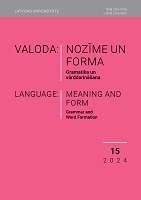Development of Lithuanian dialects in the active Baltic-Slavic contact zone: Signs of the decay of morphological structure
Development of Lithuanian dialects in the active Baltic-Slavic contact zone: Signs of the decay of morphological structure
Author(s): Nijolė TuomienėSubject(s): Language studies, Morphology, Syntax, Baltic Languages, Philology
Published by: Latvijas Universitātes Akadēmiskais apgāds
Keywords: Southern Aukštaitian subdialect of Lithuanian; local Belarusian dialect po prostu; interference at morphological level; language contacts;
Summary/Abstract: This article presents sociolinguistic research of the Southern Aukštaitian subdialect of Lithuanian spoken on both sides of the border between Southeastern Lithuania and Northwestern Belarus. It should be noted that the Lithuanian dialect no longer forms a homogeneous area, as it is losing out to Belarusian, which is called po prostu in the studied areas. When the Lithuanian dialect lost its function, many Lithuanian speakers switched to the Belarusian dialect alone. The change of languages in the same areas over two or three generations has led to a very close relationship between the languages. The object of the investigation is two linguistic borderland areas: the first one includes 17 points of the southeastern borderland of Lithuania from Atlas of the Lithuanian Language (LKA) and the second one is comprised of four points, which constitute the continuation of Southern Aukštaitian beyond the borders of Lithuania. The material covers almost seven decades, from the second half of the 20th century to the second decade of the 21st century. The aim of the study is to analyse the most important changes in the morphological system of the Southern Aukštaitian dialect used in the two areas. The article analyses the changes of contact origin, which have occurred in the Lithuanian language systems of nouns and verbs at the morphological level. Due to constant interaction with Slavic languages, the Lithuanian dialect has undergone complex degenerative changes in its grammatical structure. The language processes are analysed using the apparent-time method (Labov 1963): the current language of three generations of informants is studied and compared.
Journal: Valoda: nozīme un forma
- Issue Year: 2024
- Issue No: 15
- Page Range: 210-226
- Page Count: 17
- Language: English

